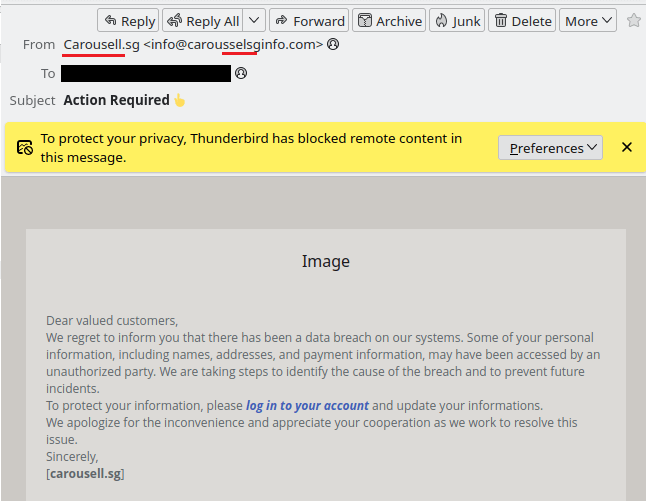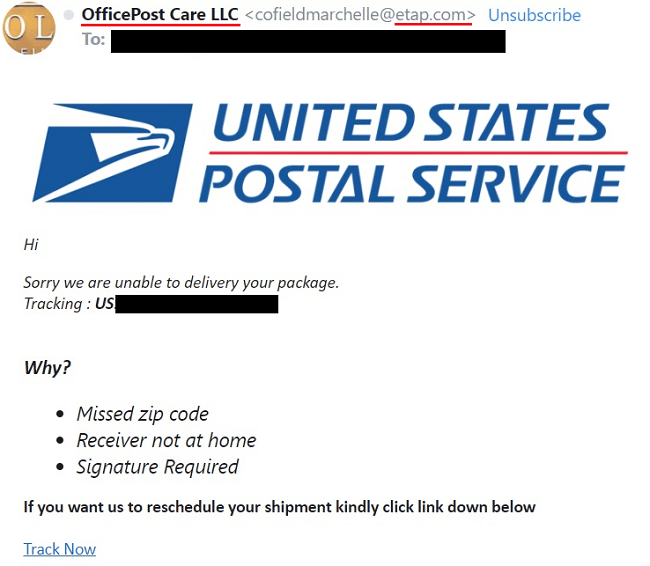What is “Redundancies Across The Organization” Email Spam
Subject: YOUR EMPLOYMENT STATUS
Dear ********,
We regret to inform you that due to a severe tax imposition on our company, we are no longer able to sustain our current workforce. As a result, we have made the difficult decision to implement redundancies across the organization.
Unfortunately, this means that we are no longer able to continue your employment with ********
. Your last working days will be [29-6-2024].
We understand the impact of this decision on you, and as a gesture of goodwill, we have attached your three months' upfront salary to assist you during this transition period. The details of your final payment are included with attached documents.
Please find attached the necessary documents regarding your redundancy and the breakdown of your final salary payment.
We appreciate your contributions to the company and regret that we have to part ways under these circumstances. Should you need any assistance or have any questions regarding your redundancy package, please do not hesitate to contact the HR department at ********,
Thank you for your understanding and cooperation during this challenging time.
Sincerely,
HR Manager
CC ********
Redundancies Across The Organization email spam is a type of phishing scam that targets individuals within an organization by pretending to be from their HR department. The emails typically claim that there have been redundancies within the company and that the recipient needs to click on a link or download an attachment for more information. This tactic preys on the fear and uncertainty that comes with potential job loss, leading unsuspecting employees to fall victim to the scam.
When recipients click on the link or download the attachment in a Redundancies Across The Organization email, they often unknowingly install malware onto their computers. This malware can then steal sensitive information, such as login credentials and financial data, or even take control of the infected system. In some cases, the malware may also spread to other devices connected to the same network, causing further damage and compromising even more data.
Interacting with Redundancies Across The Organization email scams poses serious risks to individuals and organizations alike. Not only can falling for the scam result in financial loss and identity theft, but it can also lead to significant disruptions in business operations. In addition, the malware installed through these scams can open the door to further cyberattacks, putting sensitive company data and customer information at risk. It is important for employees to remain vigilant and report any suspicious emails to their IT department to prevent falling victim to these types of phishing scams.

How to stop email spam like “Redundancies Across The Organization”
You can use an anti-spam filter which will block most known sources of spam before they even reach your inbox. MailWasher is a program you may try. It filters spam and lets you preview emails on a server without downloading them onto your computer. MailWasher has customizable spam filters, uses bayesian filtering and works with all major email programs: Outlook, Outlook Express, Thunderbird, GMail, etc.
Types of spam email
Spam email messages can be approximately divided into three categories: those that prompt you to download and run something, those that ask for your personal data, and those asking you to make payments. Let’s take a closer look at each one so we can better protect ourselves from these scams.
-
Emails with attachments
In the first case the email contains an attachment which it prompts you to open. Those attachments may consist of executable files or they may be Microsoft Word or Excel documents containing malicious macro scripts. Once you launch the executable file or allow the document to run its macros, malware downloads onto your device and wreaks all kinds of havoc with it.
The malware may range from adware showing extra ads on your browsers to ransomware that encrypts your files and aks for payment to decrypt them.
-
Phishing emails
The second type of spam (phishing emails) try to trick you into entering your name, logins, passwords, credit card details, etc. on what you think are legitimate and respectable websites.
Those emails usually pretend to be messages from well-known websites that you are probably registered on, and prompt you to follow a link to their site for some reason (for example, there is something wrong with your account). The provided link leads to fake site of course, and the data you enter ends up in the hands of cybercriminals.
-
Advance-fee scam and sextortion scam emails
Finally there are the emails urging people make payments. These can be further divided into two types: the first type, asking people to invest into something, to pay some money now and get back much more later (the advance-fee scam); the second one, scaring people into paying to prevent something bad from happening.
An example of the first one is the well-known Nigerian Prince email. A example of the second is sextortion scam: emails that claim that the email author has access to the victims’s web cam and has the victims intimate videos, which the criminal threatens to publish unless paid off.

How to find out that the email is scam

- Check the sender’s address – if the address doesn’t match up with what you expect from that company, then it’s very likely that the email is scam. Be aware though that the sender address can be faked, so if the address looks legitimate it is not guaranteed that the email is legit.
- Look for spelling and grammar mistakes and weird phrasing – real emails from reputable companies are far less likely to have those.
- Watch for urgent requests – legitimate companies will never ask customers for sensitive information such as credit card numbers via email, so if an email suddenly asks for urgent action like requesting payment details within few hours, chances are high this could potentially be a scam attempt.
How to protect yourself from email scam
- Use an email filtering service – email filtering services like MailWasher Pro allow you to filter out unwanted messages before they reach your inbox. These services use sophisticated algorithms to identify suspicious content in incoming emails and block them automatically so that only legitimate messages make it through the filter.
- Avoid clicking on suspicious links – if you receive an email with a link that looks suspicious, do not click on it! Even if the sender appears familiar, chances are high that the link is malicious and could lead you down a path of malware infection or identity theft. It is best not to open any unknown links at all.
- Don’t respond directly – never reply directly to spam emails as this will confirm for spammers that your address is active which may result in more unsolicited mail being sent your way. Instead, mark these messages as “Spam” within your email client/service provider so that their filters can better detect similar types of mail next time.
- Keep software up-to-date – make sure all software installed onto devices such as computers and smartphones is kept up-to date with latest security patches released by developers; this helps reduce risk posed by cyber criminals who exploit vulnerabilities found in outdated versions of programs including email clients.
- Use anti virus protection – install reputable antivirus solutions onto any device receiving emails; most modern day anti viruses come equipped with advanced features such as real time scanning which help detect potential threats immediately upon opening files attached to emails.
